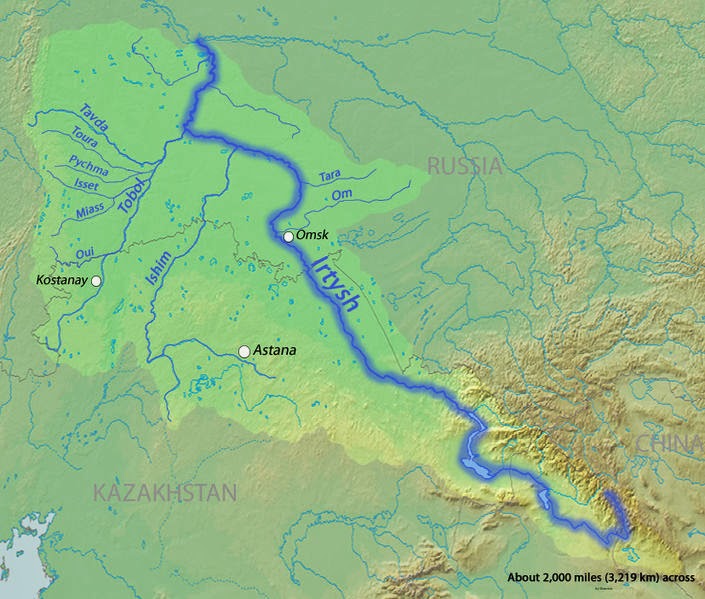
The Irtysh River is a river in Siberia and Kazakhstan and is the chief tributary of the Ob River.
Irtysh’s main affluents are the Tobol River and the Ishim River. The Ob-Irtysh system forms a major drainage basin in Asia, encompassing most of Western Siberia and the Altai Mountains.
Geography
From its origins as the Kara-Irtysh (Black Irtysh) in the Mongolian Altay mountains in Xinjiang, China, the Irtysh flows northwest through Lake Zaysan in Kazakhstan, meeting the Ishim and Tobol rivers before merging with the Ob near Khanty-Mansiysk in western Siberia, Russia after 4,248 kilometres (2,640 mi).
The name Black Irtysh (Kara-Irtysh in Kazakh, or Cherny Irtysh in Russian) is applied by some authors, especially in Russia and Kazakhstan, to the upper course of the river, from its source entering Lake Zaysan. The term White Irtysh, in opposition to the Black Irtysh, was occasionally used in the past to refer to the Irtysh below lake Zaysan; now this usage is largely obsolete.
History
A number of Mongol and Turkic peoples occupied the river banks for many centuries. In 657, Tang Dynasty general Su Dingfang defeated Ashina Helu, qaghan of the Western Turkic Khaganate, at the Battle of Irtysh River, ending the Tang campaign against the Western Turks. Helu’s defeat ended the Khaganate, strengthened Tang control of Xinjiang, and led to Tang suzerainty over the western Turks.
In the 15th and 16th centuries the lower and middle courses of the Irtysh lay within the Tatar Khanate of Sibir, which the Russians conquered in the 1580s. In the 17th century the Zunghar Khanate, formed by the Mongol Oirat people, became Russia’s southern neighbor, and controlled the upper Irtysh. The Russians founded the cities of Omsk in 1716, Semipalatinsk in 1718, Ust-Kamenogorsk in 1720, and Petropavlovsk in 1752.
The Chinese Qing Empire conquered the Zunghar state in the 1750s. This prompted an increase in the Russian authorities’ attention to their borderland; in 1756, the Orenburg Governor Ivan Neplyuyev even proposed the annexation of the Lake Zaysan region, but this project was forestalled by Chinese successes. Concerns were raised in Russia (1759) about the (theoretical) possibility of a Chinese fleet sailing from Lake Zaysan down the Irtysh and into Western Siberia. A Russian expedition visited Lake Zaysan in 1764, and concluded that such a riverine invasion would not be likely. Nonetheless, a chain of Russian pickets was established on the Bukhtarma River, north of Lake Zaysan. Thus the border between the two empires in the Irtysh basin became roughly delineated, with a (sparse) chain of guard posts on both sides.
The situation in the borderlands in the mid-19th century is described in a report by A.Abramof (1865). Even though the Zaysan region was recognized by both parties as part of the Qing Empire, it had been annually used, by fishing expeditions sent by the Siberian Cossack Host. The summer expeditions started in 1803, and in 1822-25 their range was expanded through the entire Lake Zaysan and to the mouth of the Black Irtysh. Through the mid-19th century, the Qing presence on the upper Irtysh was mostly limited to the annual visit of the Qing amban from Chuguchak to one of the Cossacks’ fishing stations (Batavski Piket).
The border between the Russian and the Qing empires in the Irtysh basin was established along the line fairly similar to China’s modern border with Russia and Kazakhstan by the Convention of Peking of 1860.The actual border line pursuant to the convention was drawn by the Protocol of Chuguchak (1864), leaving Lake Zaysan on the Russian side.The Qing Empire’s military presence in the Irtysh basin crumbled during the Dungan revolt (1862–77). After the fall of the rebellion and the reconquest of Xinjiang by Zuo Zongtang, the border between the Russian and the Qing empires in the Irtysh basin was further slightly readjusted, in Russia’s favor, by the Treaty of Saint Petersburg (1881).
Note : The above story is based on materials provided by Wikipedia










